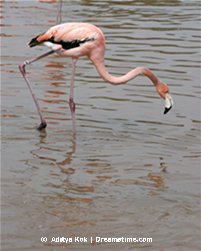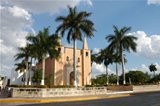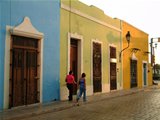Flamingo Facts
Birds of a Feather
Some of these flamingo facts are well-known. Others...well, have you ever even stopped to wonder why flamingo birds like to stand on one leg? That's a though one, uh?!

Best known flamingo facts
- They are a pale to deep pink in color
- With their very long neck and legs they are the bird-version of a top-model
- Flamingos prefer shallow saline waters and lagoons with muddy bottoms, hence their webbed feet
Not all flamingos are pink though. The little ones are born grey or white and turn pink after having eaten loads of small shrimp, crustaceans and algae with high levels of beta carotene. Their favorite dinner on the Yucatan Peninsula is a tiny crustacean called artemia. If you encounter a white adult flamingo in the wild it`s probably sick and/or it has a poor diet.
Some lesser known flamingo facts
When I was little and I got the hickups my mother told me (she was right of course) to drink water while holding my head upside down to stop it. Well, flamingos eat like that. They stick their head upside down in the mud and - much like a whale - sieve it through specially developed organs in their bill.
In the '60s, huge concentrations of "phoenicopteris rubber plasticus" were found in lawns across the USA, giving the flamingo a cult-status.

The mud is expelled and the food stays trapped. That makes flamingo birds unique among their species. I guess that also means they never get hickups.
Flamingos are difficult to classify. They are almost like an assembled species: the body of a stork and the webbed feet of a goose adapted for wading in shallow lagoons. Scientists have discovered that on a protein level a flamingo egg is related to the heron. So rather than make this mixture fit into a bird family that wouldn't be altogether justifyable the flamingo was given its own family called phoenicopteridae. Within this family the Caribbean flamingo or greater flamingo found on the Yucatan peninsula is classified as phoenicopterus ruber ruber.
More flamingo facts
- Flamingos don't like to be disturbed. You shouldn't go to close to them because they are likely to get upset and fly away. I know it can be tempting to try and get great pictures from up close, but it won't be so nice to have the Semarnap (the Mexican environmental police) confiscate your memory stick and give you a fine. Better bring a good close-up lense along with your camera.
- Have you noticed a flamingos' leg bends backwards? Actually, it only seems that way, but what we perceive as their knee is in fact... their ankle! In other words, would it bend the other way that would be really queer: then their feet would be turned backwards!
- Flamingos make a honking sound like goose. Ever heard hundreds of geese squeaking all together? Help!!
- On the Yucatan Peninsula breeding time starts halfway through March with courtship and prenuptual agreements. When the flamingo finds a mate the couple starts 'dancing'. Males emit guttural sounds and both male and female klap their wings. The actual act of 'lovemaking' takes only 5 to 12 seconds!
- Flamingos build their nest in the form of a volcano-shaped cone. In the hole on top they lay one (seldom a flamingo lays more than one) whitish egg. When it comes to incubating the eggs, both parents have the same job description. The young hatch after about one month. Unlike their parents the babies will have a straight bill. After some weeks it starts to bend and turns orange with a black tip. The chicks start filter feeding when their bill is completely curved, that is when they are a couple of months old. Until then the parents produce a fatty milk which they then regurgitate to feed their offspring.
- Flamingos can live up to about 20 years in the wild and have been known to reach 50 years in captivity
Funny flamingo facts
- A flamingos' brain is smaller than its eye. That's really small!
- Would you believe the ancient Romans feasted on flamingo tongues? They considered it a delicacy. Hundreds of years later the 18th century pirate William Dampiere (who frecuently attacked ships in the Bay of Campeche) describes roasted flamingo tongues as his favorite dish. I think I'll pass!
Now back to the question at the beginning: Why oh why do flamingos like to stand on one leg? To give the other one a rest? To conserve body heat and energy? I'll have to owe you the answer to this one, since no-one has come up with a watertight explanation yet.
Flamingo facts >> Cool flamingo stuff













